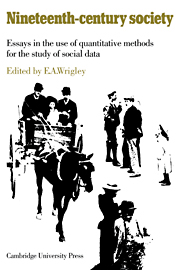Book contents
- Frontmatter
- Contributors
- Contents
- Introduction
- 1 The census, 1801–1891
- 2 The study of family structure
- 3 Sources of inaccuracy in the 1851 and 1861 censuses
- 4 Standard tabulation procedures for the census enumerators' books 1851–1891
- 5 Sampling in historical research
- 6 The use of information about occupation
- 7 The use of published census data in migration studies
- 8 Criminal statistics and their interpretation
- 9 The incidence of education in mid-century
- Notes
- Bibliography
- Index
2 - The study of family structure
Published online by Cambridge University Press: 05 November 2011
- Frontmatter
- Contributors
- Contents
- Introduction
- 1 The census, 1801–1891
- 2 The study of family structure
- 3 Sources of inaccuracy in the 1851 and 1861 censuses
- 4 Standard tabulation procedures for the census enumerators' books 1851–1891
- 5 Sampling in historical research
- 6 The use of information about occupation
- 7 The use of published census data in migration studies
- 8 Criminal statistics and their interpretation
- 9 The incidence of education in mid-century
- Notes
- Bibliography
- Index
Summary
Dahrendorf has noted that ‘Sociologists still like to invent their history so as to lend profile to their statements about the present.’ To a remarkable extent this is still true of the sociology of the family. Until recently our knowledge of family life in the past was usually derived from one or more of three kinds of sources: novels, usually by middle class writers; largely impressionistic writings, frequently reformatory or didactic in aim, by middle class contemporaries; and anecdotes recounted to investigators by elderly respondents, some of which they in turn had heard from others even older than themselves. The first two were inevitably rather impressionistic and based on incomplete knowledge; in addition their didactic aims encouraged an emphasis on social pathology. Their evidence is almost certainly not therefore representative of the population as a whole. The anecdotal sources are subject to all the well known problems of long period recall which seem to blur away the harshness of the past and the sufferings of substantial minority groups, and lead people to portray the past through rose-coloured (or, occasionally, grimy) spectacles. This bias in recall data on the family appears to be common to all cultures at all periods of history.
All these sources, then, tend to give a picture of family and social life in the past which exaggerates in one direction or the other, which portrays the historical family either as highly integrated, or, alternatively, as highly disrupted.
- Type
- Chapter
- Information
- Nineteenth Century Society , pp. 47 - 81Publisher: Cambridge University PressPrint publication year: 1972
- 4
- Cited by



